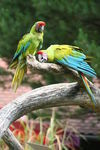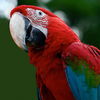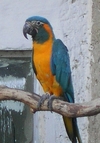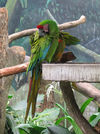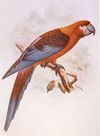Genus Ara
Great Green Macaw - The Great Green Macaw, Ara ambiguus, also known as Buffon's Macaw or the Great Military Macaw, is a Central and South American parrot found in Nicaragua, Costa Rica, Panama, Colombia and Ecuador. Two allopatric subspecies are recognized, the nominate subspecies is found in Central America to northern Colombia, while A. a. guayaquilensis is found in western Ecuador and possibly south-western Colombia.
Blue-and-yellow Macaw - It can reach 76–86 cm long and weigh 900 to 1300 g . It is vivid in appearance with blue wings and tail, dark blue chin, golden under parts and a green forehead. Its beak is black, and very strong for crushing nuts. The naked face is white, turning pink in excited birds, and lined with small black feathers.
Ara atwoodi - Clark, the zoologist and binomial authority on the parrot, initially included these macaws in Ara guadeloupensis. On discovering Atwood's writings, however, Clark listed them separately, considering them distinct
Red-and-green Macaw - This is the largest of the Ara genus, widespread in the forests and woodlands of northern and central South America. However, in common with other macaws, in recent years there has been a marked decline in its numbers due to habitat loss and illegal capture for the parrot trade.
Wagler's Macaw - The Blue-throated Macaw lives in the savanna of the Beni Department of Bolivia, nesting in "Islas" of palm trees that dot the level plains. It is not a forest dwelling bird.
Ara guadeloupensis - Rothschild distinguished two different macaws, the Mythical Macaw By 1760 the Lesser Antillean Macaw was extremely rare and shortly after it became extinct.
Scarlet Macaw - It is about 81 centimetres long, of which more than half is the pointed, graduated tail typical of all macaws. The average weight is about 1 kilogram . The plumage is mostly scarlet, but the rump and tail-covert feathers are light blue, the greater upperwing coverts are yellow, the upper sides of the flight feathers of the wings are dark blue as are the ends of the tail feathers, and the undersides of the wing and tail flight feathers are dark red with metallic gold iridescence. Some individuals may have green in the wings. Three subspecies present varying widths in their yellow wing band. There is bare white skin around the eye and from there to the bill. Tiny white feathers are contained on the face patch. The upper mandible is mostly pale horn in color and the lower is black. The only difference between ages is that young birds have dark eyes, and adults have light yellow eyes. It is frequently confused with the slightly larger Red-and-green Macaw, which has more distinct red lines in the face an
Military Macaw - There are three subspecies, A. m. militaris, A. m. mexicana, and A. m. boliviana. The differences between the subspecies are slight and pertain to minor variations in color and size, generally 70–80 cm, with the militaris subspecies being the smallest and the mexicana being the largest.
Red-fronted Macaw - The Red-fronted Macaw is 55–60 cm long. It is mostly green, and has a red forehead, a red patch over the ears and bright red to orange edged under wing coverts. It has an area of pinkish skin around the eyes extending to the beak. It has red at the bend of wings and blue primary wing feathers.
Chestnut-fronted Macaw - The Chestnut-fronted Macaw or Severe Macaw is one of the largest of the Mini-Macaws. It reaches a size of around 45 cm of which around half is the length of the tail.
Hispaniolan Macaw - A pair was kept in the royal menagerie at Schönbrunn Palace, Vienna, Austria from 1760.

